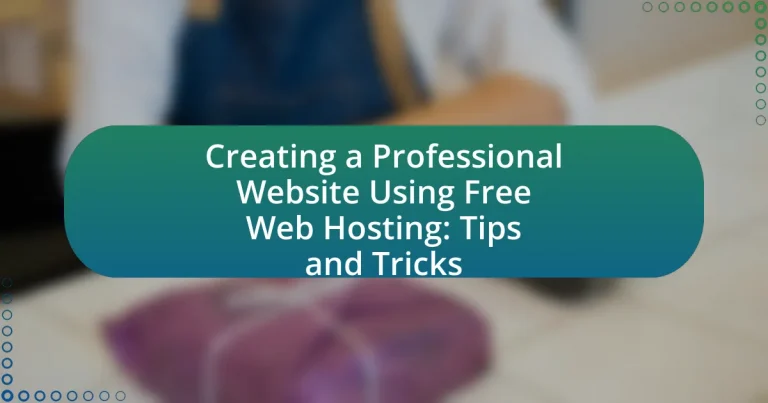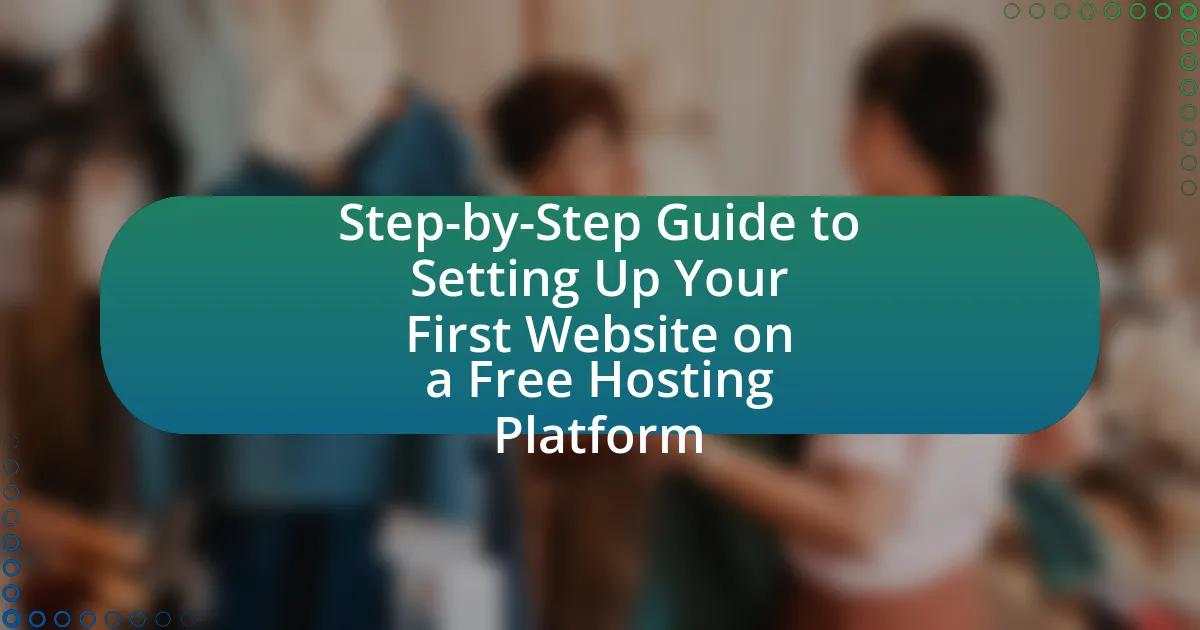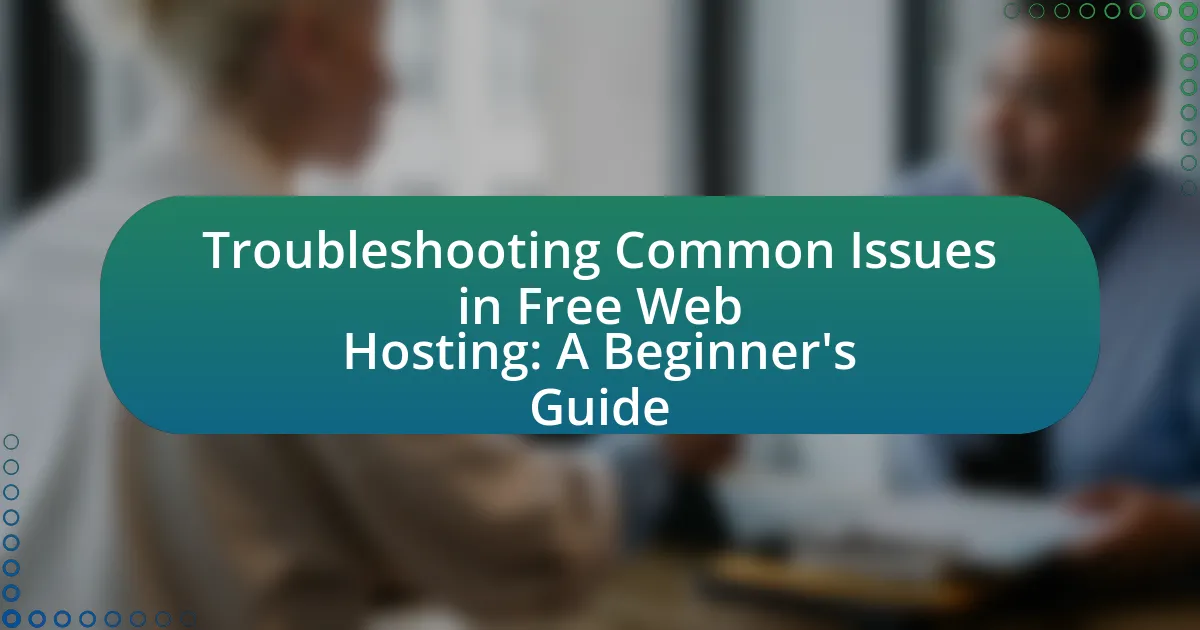Creating a professional website using free web hosting involves building an online presence without incurring hosting costs, utilizing platforms that offer basic services at no charge. This article outlines the advantages and limitations of free web hosting, including essential features to consider, comparisons with paid options, and key elements that contribute to a professional website. It also discusses best practices for website design, content creation, and promotion, as well as strategies for transitioning to paid hosting when necessary. Additionally, the article addresses common challenges and troubleshooting tips associated with free web hosting services, providing a comprehensive guide for individuals and small businesses looking to establish an effective online presence.

What does it mean to create a professional website using free web hosting?
Creating a professional website using free web hosting means building an online presence without incurring hosting costs, typically utilizing platforms that offer basic services at no charge. This approach allows individuals or businesses to establish a website with limited resources, often featuring templates and tools for design and functionality. However, free web hosting may come with restrictions such as limited storage, bandwidth, and the presence of ads, which can affect the site’s professionalism. According to a 2021 survey by HostingAdvice, 60% of users reported that free hosting services often lack essential features, which can hinder the website’s effectiveness and credibility.
How can free web hosting services support website creation?
Free web hosting services support website creation by providing users with the necessary infrastructure to build and publish their sites without financial investment. These services typically offer essential features such as storage space, bandwidth, and website builders, enabling individuals and small businesses to establish an online presence. For instance, platforms like WordPress.com and Wix allow users to create websites using templates and drag-and-drop tools, making the process accessible even for those with limited technical skills. Additionally, free hosting often includes basic customer support and community forums, which can assist users in troubleshooting issues and enhancing their website functionality.
What features should you look for in a free web hosting service?
When selecting a free web hosting service, prioritize features such as storage space, bandwidth, uptime reliability, customer support, and ease of use. Adequate storage space ensures that your website can accommodate content without frequent upgrades, while sufficient bandwidth allows for smooth traffic flow without slowdowns. Uptime reliability, ideally above 99.9%, guarantees that your website remains accessible to visitors. Responsive customer support is crucial for resolving issues promptly, and an intuitive interface simplifies the website management process. These features collectively enhance the functionality and professionalism of a website hosted on a free platform.
How do free web hosting services compare to paid options?
Free web hosting services typically offer limited features, lower performance, and less reliability compared to paid options. Paid web hosting services generally provide enhanced resources, such as increased storage, bandwidth, and customer support, which are crucial for professional websites. For instance, a study by HostingAdvice found that paid hosting plans can offer uptime guarantees of 99.9%, while free hosting often lacks such reliability, leading to potential downtime and slower loading speeds. Additionally, free hosting may include advertisements and limited customization options, which can detract from a professional appearance. In contrast, paid services allow for greater control over branding and functionality, making them a more suitable choice for serious website owners.
What are the key elements of a professional website?
The key elements of a professional website include a clean and user-friendly design, mobile responsiveness, fast loading times, quality content, clear navigation, and effective calls to action. A clean design enhances user experience and builds trust, while mobile responsiveness ensures accessibility across devices, with over 50% of web traffic coming from mobile users. Fast loading times, ideally under three seconds, reduce bounce rates, as studies show that 40% of users abandon a site that takes longer than three seconds to load. Quality content engages visitors and improves SEO, while clear navigation helps users find information easily, contributing to a positive experience. Effective calls to action guide users towards desired actions, such as signing up or making a purchase, which is crucial for conversion rates.
How does website design impact professionalism?
Website design significantly impacts professionalism by influencing user perception and trustworthiness. A well-structured, visually appealing website conveys competence and attention to detail, which are essential traits for any professional entity. Research indicates that 75% of users judge a company’s credibility based on its website design, highlighting the direct correlation between design quality and perceived professionalism. Furthermore, consistent branding, intuitive navigation, and mobile responsiveness enhance user experience, reinforcing a professional image. Thus, effective website design is crucial for establishing and maintaining a professional reputation in the digital landscape.
What content is essential for a professional website?
A professional website must include essential content such as a clear homepage, an about page, a services or products page, contact information, and testimonials or case studies. The homepage serves as the first impression, providing an overview of the website’s purpose. The about page establishes credibility by sharing the organization’s mission and values. A services or products page details offerings, helping visitors understand what is available. Contact information is crucial for facilitating communication, while testimonials or case studies build trust by showcasing positive experiences from previous clients. These elements collectively enhance user experience and establish professionalism, which is vital for attracting and retaining visitors.
Why choose free web hosting for your professional website?
Choosing free web hosting for a professional website can significantly reduce initial costs, making it an attractive option for startups and small businesses. Free web hosting services allow users to establish an online presence without financial investment, which is crucial for those with limited budgets. According to a report by HostingAdvice, nearly 70% of small businesses operate on tight budgets, and free hosting can help them allocate resources to other essential areas like marketing and product development. Additionally, many free hosting platforms offer user-friendly interfaces and essential features, enabling users to create and manage their websites easily.
What are the advantages of using free web hosting?
The advantages of using free web hosting include cost savings, ease of access, and basic functionality for small projects. Cost savings are significant as users do not incur monthly fees, making it ideal for individuals or startups with limited budgets. Ease of access is another advantage, as many free hosting services offer user-friendly interfaces and quick setup processes, allowing users to launch websites without technical expertise. Basic functionality, such as storage space and bandwidth, is typically sufficient for personal blogs or small business sites, enabling users to establish an online presence without financial commitment.
What limitations should you be aware of with free web hosting?
Free web hosting has several limitations that users should be aware of. These limitations include restricted storage space, bandwidth caps, and the presence of advertisements on hosted sites. For instance, many free hosting services offer limited disk space, often ranging from 500 MB to 2 GB, which can hinder the ability to upload large files or host extensive content. Additionally, bandwidth restrictions can lead to slow loading times or site downtime if traffic exceeds the allocated limit. Furthermore, free hosting providers typically display their own ads on users’ websites, which can detract from the professional appearance of the site and may not align with the user’s branding. These factors collectively impact the overall functionality and professionalism of a website hosted on a free platform.
How can you effectively transition from free web hosting to a paid service?
To effectively transition from free web hosting to a paid service, first, select a reliable paid hosting provider that meets your website’s needs. This involves researching various hosting options, comparing features such as storage, bandwidth, customer support, and pricing. Once a provider is chosen, back up your website data from the free host, ensuring all files and databases are securely saved. Next, set up your new paid hosting account and upload your website files to the new server. After confirming that everything is functioning correctly, update your domain’s DNS settings to point to the new hosting provider. This process minimizes downtime and ensures a smooth transition. According to a 2021 survey by HostingAdvice, 70% of users reported improved website performance after switching to a paid hosting service, highlighting the benefits of this transition.
What strategies can enhance your website’s professionalism on a budget?
To enhance your website’s professionalism on a budget, focus on using a clean and responsive design, optimizing content for clarity, and utilizing free tools for branding. A clean design ensures that visitors can navigate easily, while responsive layouts improve accessibility across devices, which is crucial as 54.8% of global web traffic comes from mobile devices. Optimizing content involves using concise language and clear headings, which can increase user engagement and reduce bounce rates. Additionally, free tools like Canva for graphics and Google Fonts for typography can elevate your site’s visual appeal without incurring costs. These strategies collectively contribute to a more professional online presence while adhering to budget constraints.
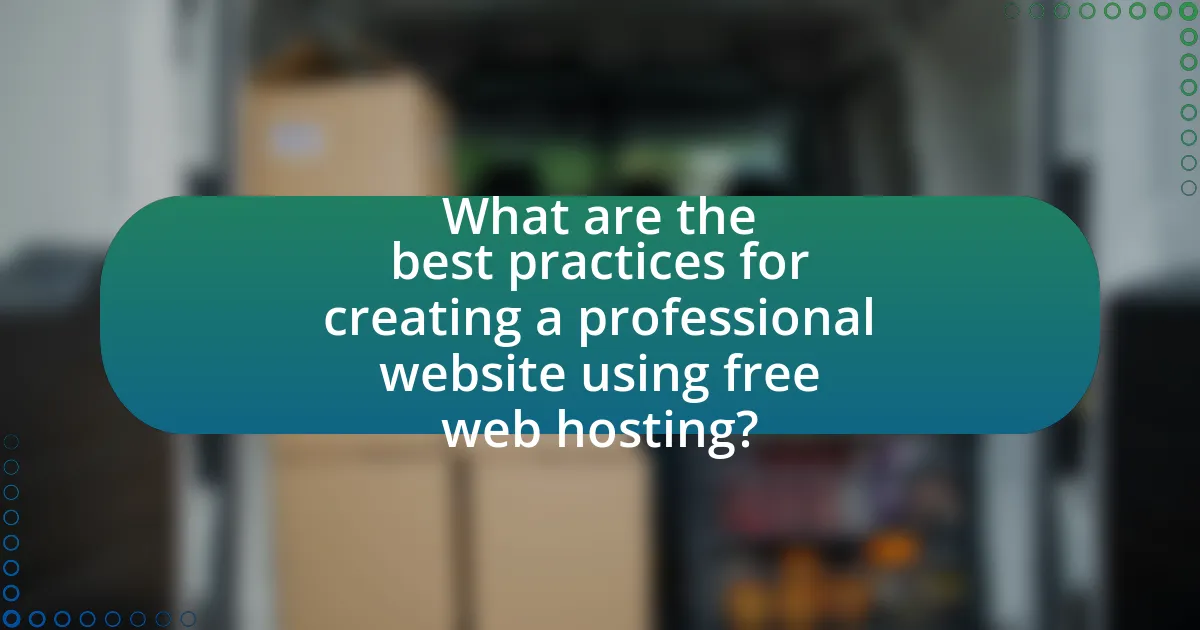
What are the best practices for creating a professional website using free web hosting?
The best practices for creating a professional website using free web hosting include selecting a reliable hosting provider, using a custom domain name, optimizing for mobile devices, and ensuring a clean, user-friendly design. Reliable hosting providers, such as WordPress.com or Wix, offer essential features like uptime guarantees and customer support, which enhance website performance. A custom domain name, rather than a subdomain, establishes credibility and improves search engine visibility. Mobile optimization is crucial, as over 50% of web traffic comes from mobile devices, according to Statista. A clean design with intuitive navigation enhances user experience, leading to longer visit durations and lower bounce rates. These practices collectively contribute to a professional online presence, even when utilizing free hosting services.
How can you optimize your website for user experience?
To optimize your website for user experience, focus on improving site speed, mobile responsiveness, and intuitive navigation. Research indicates that 47% of users expect a web page to load in two seconds or less, and a delay of just one second can lead to a 7% reduction in conversions. Implementing responsive design ensures that your website functions well on various devices, which is crucial as mobile traffic accounts for over 50% of global web traffic. Additionally, simplifying navigation enhances user satisfaction, as 94% of users cite easy navigation as a key factor in their online experience.
What design principles should you follow for a professional look?
To achieve a professional look in web design, you should follow principles such as simplicity, consistency, and usability. Simplicity ensures that the design is uncluttered, allowing users to focus on the content without distractions. Consistency across elements like fonts, colors, and layout creates a cohesive experience, reinforcing brand identity. Usability emphasizes intuitive navigation and accessibility, ensuring that users can easily interact with the site. Research indicates that websites adhering to these principles see improved user engagement and satisfaction, as evidenced by studies showing that 94% of first impressions relate to design elements.
How can you ensure your website is mobile-friendly?
To ensure your website is mobile-friendly, implement responsive web design techniques that allow your site to adapt to various screen sizes. This can be achieved by using flexible grid layouts, scalable images, and CSS media queries. According to Google, 61% of users are unlikely to return to a mobile site they had trouble accessing, highlighting the importance of mobile optimization for user retention and engagement.
What tools and resources can assist in building your website?
Website builders like WordPress, Wix, and Squarespace are essential tools for building a website. These platforms provide user-friendly interfaces, customizable templates, and integrated hosting solutions, making it easier for users to create professional websites without extensive coding knowledge. According to a 2021 survey by W3Techs, WordPress powers over 40% of all websites on the internet, highlighting its popularity and effectiveness as a website-building tool. Additionally, resources such as Canva for graphic design, Google Analytics for tracking website performance, and GitHub for version control further enhance the website development process, ensuring a comprehensive approach to creating and managing a website.
Which website builders are compatible with free hosting services?
Website builders compatible with free hosting services include WordPress.com, Wix, Weebly, and Jimdo. These platforms offer free plans that allow users to create and publish websites without incurring hosting fees. For instance, WordPress.com provides a free tier with basic features, while Wix and Weebly offer drag-and-drop interfaces that simplify website creation on their free hosting options. Jimdo also allows users to build websites for free, making it accessible for those seeking no-cost solutions.
What free resources can help with website content creation?
Free resources that can assist with website content creation include platforms like WordPress, which offers customizable templates and plugins for easy content management. Additionally, Google Docs provides collaborative writing tools that facilitate content drafting and editing. Canva is another valuable resource, allowing users to create visually appealing graphics and images for their websites without any cost. Furthermore, Unsplash and Pexels offer a vast library of high-quality, royalty-free images that can enhance website content. These resources are widely recognized for their effectiveness in supporting content creation, making them reliable options for anyone looking to build a professional website.
How can you promote your professional website effectively?
To promote your professional website effectively, utilize a combination of search engine optimization (SEO), social media marketing, and content marketing. SEO enhances your website’s visibility on search engines, driving organic traffic; for instance, optimizing for relevant keywords can increase your site’s ranking, as evidenced by studies showing that 75% of users never scroll past the first page of search results. Social media marketing allows you to reach a broader audience by sharing engaging content and updates, with platforms like Facebook and LinkedIn providing targeted advertising options that can significantly boost traffic. Content marketing, through blogs or articles, establishes authority in your field and encourages sharing, which can lead to increased backlinks and higher search rankings.
What are the best free marketing strategies for your website?
The best free marketing strategies for your website include leveraging social media platforms, utilizing search engine optimization (SEO), engaging in content marketing, and implementing email marketing campaigns. Social media platforms like Facebook, Instagram, and Twitter allow for organic reach and audience engagement, which can drive traffic to your website. SEO enhances your website’s visibility on search engines, increasing the likelihood of attracting visitors; for instance, optimizing for relevant keywords can improve search rankings. Content marketing, through blogs or videos, provides valuable information that can attract and retain an audience, establishing authority in your niche. Email marketing enables direct communication with potential customers, fostering relationships and encouraging repeat visits. These strategies are effective because they require minimal financial investment while maximizing outreach and engagement potential.
How can social media enhance your website’s visibility?
Social media enhances your website’s visibility by driving traffic and increasing brand awareness. When users share content from your website on platforms like Facebook, Twitter, and Instagram, it exposes your site to a broader audience, potentially leading to higher visitor numbers. According to a study by HubSpot, social media generates over 31% of referral traffic to websites, demonstrating its effectiveness in attracting visitors. Additionally, engaging with users on social media can improve your search engine rankings, as search engines consider social signals as a factor in their algorithms. This combination of increased traffic and improved SEO contributes significantly to enhanced visibility for your website.
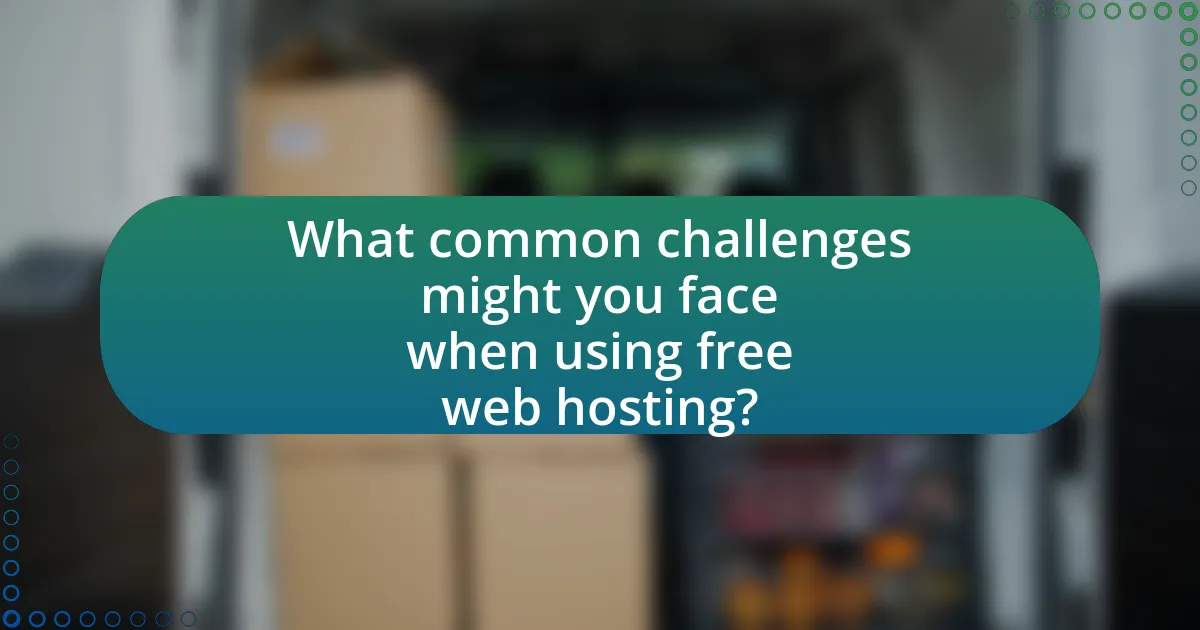
What common challenges might you face when using free web hosting?
Common challenges faced when using free web hosting include limited storage and bandwidth, lack of customer support, and potential security vulnerabilities. Limited storage and bandwidth can restrict website growth and performance, as many free hosting services impose strict caps, which can lead to slow loading times or downtime. The absence of reliable customer support can hinder troubleshooting and resolution of issues, leaving users without assistance when problems arise. Additionally, free web hosting often lacks robust security measures, making websites more susceptible to hacking and data breaches, as many providers do not offer SSL certificates or regular backups. These factors collectively impact the overall functionality and professionalism of a website hosted on a free platform.
How can you troubleshoot common issues with free web hosting?
To troubleshoot common issues with free web hosting, first identify the specific problem, such as slow loading times, downtime, or error messages. Next, check the hosting provider’s status page for any ongoing outages or maintenance notifications. If the issue persists, clear your browser cache and cookies, as this can resolve display problems. Additionally, verify that your domain settings are correctly configured, including DNS records. If you encounter issues with website functionality, review your website’s code for errors or conflicts, and ensure that any plugins or themes are up to date. Finally, consult the hosting provider’s support resources or community forums for guidance, as many common issues have documented solutions.
What are the most frequent technical problems encountered?
The most frequent technical problems encountered when creating a professional website using free web hosting include limited bandwidth, unreliable uptime, and lack of customer support. Limited bandwidth can lead to slow loading times and site crashes during high traffic periods, which negatively impacts user experience. Unreliable uptime often results in websites being inaccessible, causing potential loss of visitors and revenue. Additionally, the lack of customer support can hinder problem resolution, leaving users without assistance when technical issues arise. These challenges are commonly reported by users of free web hosting services, highlighting the importance of considering these factors when selecting a hosting provider.
How can you resolve downtime or performance issues?
To resolve downtime or performance issues, regularly monitor website performance using tools like Google PageSpeed Insights or GTmetrix to identify bottlenecks. Implementing content delivery networks (CDNs) can enhance loading speeds by distributing content across multiple servers. Additionally, optimizing images and minimizing HTTP requests can significantly improve performance. According to a study by Akamai, a 100-millisecond delay in website load time can decrease conversion rates by 7%. Therefore, addressing these factors can lead to improved uptime and user experience.
What should you do if you outgrow your free web hosting service?
If you outgrow your free web hosting service, you should upgrade to a paid hosting plan that meets your website’s needs. Upgrading allows for increased storage, bandwidth, and additional features that free services typically lack, such as better security and customer support. Many reputable hosting providers offer scalable plans, enabling you to choose a package that aligns with your website’s growth. For instance, according to a 2021 survey by HostingAdvice, 70% of users reported improved performance after switching from free to paid hosting services, highlighting the benefits of investing in a reliable hosting solution.
How can you prepare for a transition to a paid hosting service?
To prepare for a transition to a paid hosting service, first assess your current website’s needs, including bandwidth, storage, and security requirements. Evaluating these factors ensures that the chosen paid hosting plan aligns with your website’s growth and performance expectations. Research various hosting providers to compare features, pricing, and customer support, as this helps identify the best fit for your specific needs. Additionally, back up your website data and files to prevent any loss during the migration process. According to a 2021 survey by HostingAdvice, 70% of users experienced downtime during transitions, highlighting the importance of thorough preparation.
What factors should you consider when choosing a new hosting provider?
When choosing a new hosting provider, consider factors such as reliability, performance, customer support, pricing, and scalability. Reliability is crucial; a study by HostingFacts indicates that 99.9% uptime is the industry standard, ensuring your website remains accessible. Performance, including speed and load times, affects user experience; Google reports that a one-second delay can reduce conversions by 7%. Customer support availability, ideally 24/7, is essential for resolving issues promptly. Pricing should align with your budget while offering necessary features, and scalability is important for accommodating future growth, as noted by research from TechRadar, which emphasizes the need for flexible plans.
What are the top tips for maintaining a professional website on free hosting?
To maintain a professional website on free hosting, prioritize consistent updates, user-friendly design, and effective content management. Regularly updating content keeps the site relevant and engaging, which is crucial for user retention. A user-friendly design enhances navigation and accessibility, ensuring visitors can easily find information. Additionally, effective content management involves organizing information logically and optimizing for search engines, which can improve visibility. These practices are essential as they contribute to a professional appearance and user experience, which are vital for credibility and engagement in a competitive online environment.
